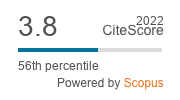Coffee Bean Grade Determination Based on Image Parameter
Abstract
Quality standard for coffee as an agriculture commodity in Indonesia uses defect system which is regulated in Standar Nasional Indonesia (SNI) for coffee bean, No: 01-2907-1999. In the Defect System standard, coffee bean is classified into six grades, from grade I to grade VI depending on the number of defect found in the coffee bean. Accuracy of this method heavily depends on the experience and the expertise of the human operators. The objective of the research is to develop a system to determine the coffee bean grading based on SNI No: 01-2907-1999. A visual sensor, a webcam connected to a computer, was used for image acquisition of coffee bean image samples, which were placed under uniform illumination of 414.5+2.9 lux. The computer performs feature extraction from parameters of coffee bean image samples in the term of texture (energy, entropy, contrast, homogeneity) and color (R mean, G mean, and B mean) and determines the grade of coffee bean based on the image parameters by implementing neural network algorithm. The accuracy of system testing for the coffee beans of grade I, II, III, IVA, IVB, V, and VI have the value of 100, 80, 60, 40, 100, 40, and 100%, respectively.
Full Text:
PDFReferences
Aksoy MA, Beghin JC. Global Agricultural Trade and Developing Countries. Washington DC: The World Bank. 2005: 298-303.
International Coffee Organization. Trade Statistics of Total Production of Exporting Countries. www. ico.org. July 2011.
Mulato S. Pengolahan Produk Primer dan Sekunder Kopi (Primer and Secunder Coffee Product Processing). Jember: Pusat Penelitian Kopi dan Kakao Indonesia. 2006.
Su TL, Kung FC, Kuo YL. Application of Back-Propagation Neural Network Fuzzy Clustering in Textile Texture Automatic Recognition System. Proceedings of The 2008 International Conference on Wavelet Analysis and Patern Recognition. Hongkong. 2008.
Chen YR, Chao K, and Kim MS. Machine Vision Technology for Agricultural Applications. Computers and Electronics in Agriculture. 2002; 36(2-3): 173-191.
Visen NS, Paliwal J, Jayas DS, White NDG. Specialist Neural Networks for Cereal Grain Classification. Biosystems Engineering, 2002; 82(2): 151–159.
Markou M, Singh SS. Color Texture Analysis of Natural Scene using Neural Networks. Proceedings of The International IEEE/INNS Joint Conference on Neural Networks (IJCNN’02). Hawaii. 2002.
Chen X, Xun Y, Li W, Zhang J. Combining Discriminant Analysis and Neural Networks for Corn Variety Identification. Computers and Electronics in Agriculture. 2010; 71(1): 48-53.
Granitto PM, Navone HD, Verdes PF, Ceccatto HA, Weed Seeds Identification by Machine Vision. Computers and Electronics in Agriculture. 2002; 33(2): 91-103.
Kondo N, Ahmad U, Mitsuji M, Murase H. Machine Vision Based Quality Evaluation of Iyokan Orange Fruit using Neural Network. Computers and Electronics in Agriculture. 2002; 29(1-2): 135-147.
Urena R, Rodriquez F, Berenquel M. A Machine Vision System for Seeds Quality Evaluation Using Fuzzy Logic. Computers and Electronics in Agriculture. 2001; 32(1): 1-20.
Soedibyo DW, Seminar KB, Ahmad U, Subrata IDM. The Development of Automatic Coffee Sorting System Based on Image Processing and Artificial Neural Network. Asian Federation for Information Technology in Agriculture 2010 International Conference. Bogor. 2010.
Carillo E, Penaloza AA. Artificial Vision to assure Coffee-Excelso Beans Quality. Proceedings of EATIS Conference. Prague. 2009.
SNI 01-2907-1999. Biji Kopi (Coffee Bean). Badan Standarisasi Nasional. 1999.
Siswoputranto. Kopi International dan Indonesia. Jakarta: Kanisius. 1993.
Haralick RM, Shanmugan K, Dinstein I. Textural Features for Image Classification. IEEE Trans, Systems, Man and Cybernetics, SCM-3. 1973; 6: 610-621.
Fadhil A. An Automatic Identification System of Human Skin Irritation. TELKOMNIKA Indonesian Journal of Electrical Engineering. 2010; 8(3): 255-264.
Mehrotra K, Mohan CK, Ranka S. Elements of Artificial Neural Networks. Cambridge: MIT Press. 1996.
Suhardi I. Analysis of Pattern Recognition Level to Pattern Variation Level: A Case Study of Character Pattern Recognition with Neural Network. TELKOMNIKA Indonesian Journal of Electrical Engineering. 2005; 3(1): 1-11.
DOI: http://doi.org/10.12928/telkomnika.v9i3.747
Refbacks
- There are currently no refbacks.

This work is licensed under a Creative Commons Attribution-ShareAlike 4.0 International License.
TELKOMNIKA Telecommunication, Computing, Electronics and Control
ISSN: 1693-6930, e-ISSN: 2302-9293
Universitas Ahmad Dahlan, 4th Campus
Jl. Ringroad Selatan, Kragilan, Tamanan, Banguntapan, Bantul, Yogyakarta, Indonesia 55191
Phone: +62 (274) 563515, 511830, 379418, 371120
Fax: +62 274 564604

